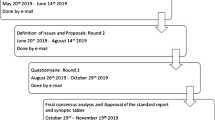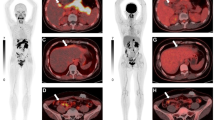Abstract
Positron emission tomography (PET) provides information about abnormal metabolic features associated with cancer, and its role in breast cancer has been widely investigated. In the past several years, combined imaging systems, such as PET/CT and PET/MRI, and dedicated breast PET devices, such as PEM and MAMMI-PET, have been developed and implemented. These new techniques have become an effective oncologic tool for staging, re-staging, monitoring response to treatment, and estimation of the long-term prognosis. The aim of this review is to summarize the established and emerging PET imaging techniques and to discuss their value in the management of breast cancer patients.



Similar content being viewed by others
References
Malvezzi M, Bertuccio P, Rosso T, et al. European cancer mortality predictions for the year 2015: does lung cancer have the highest death rate in EU women? Ann Oncol. 2015;26:779–86. doi:10.1093/annonc/mdv001.
Bosetti C, Bertuccio P, Levi F, et al. The decline in breast cancer mortality in Europe: an update (to 2009). Breast. 2012;21:77–82.
Carlson RW, Allred DC, Anderson BO, et al. Invasive breast cancer. J Natl Compr Canc Netw. 2011;9:136–222.
Sardanelli F, Boetes C, Borisch B, Decker T, Federico M, Gilbert FJ, et al. Magnetic resonance imaging of the breast: recommendations from the EUSOMA working group. Eur J Cancer. 2010;46(8):1296–316.
Pinker K, Bogner W, Baltzer P, Gruber S, Bickel H, Brueck B, et al. Improved diagnostic accuracy with multiparametric magnetic resonance imaging of the breast using dynamic contrast-enhanced magnetic resonance imaging, diffusion-weighted imaging, and 3-dimensional proton magnetic resonance spectroscopic imaging. Invest Radiol. 2014;49(6):421–30.
Pinker K, Bogner W, Baltzer P, Karanikas G, Magometschnigg H, Brader P, et al. Improved differentiation of benign and malignant breast tumors with multiparametric 18fluorodeoxyglucose positron emission tomography magnetic resonance imaging: a feasibility study. Clin Cancer Res. 2014;20(13):3540–9. doi:10.1158/1078-0432.CCR-13-2810.
Baltzer PA, Dietzel M. Breast lesions: diagnosis by using proton MR spectroscopy at 1.5 and 3.0 T—systematic review and meta-analysis. Radiology. 2013;267(3):735–46.
Kong EJ, Chun KA, Bom HS, Lee J, Lee SJ, Cho IH. Initial experience of integrated PET/MR mammography in patients with invasive ductal carcinoma. Hell J Nucl Med. 2014;17(3):171–6.
Warburg O. Metabolism of tumors. London:constable and Company; 1930.
Groheux D, Espié M, Giacchetti S, Hindié E. Performance of FDG PET/CT in the clinical management of breast cancer. Radiology. 2013;266(2):388–405. doi:10.1148/radiol.12110853.
Avril N, Rosé CA, Schelling M, et al. Breast imaging with positron emission tomography and fluorine-18 fluorodeoxyglucose: use and limitations. J Clin Oncol. 2000;18(20):3495–502.
Kalles V, Zografos GC, Provatopoulou X, et al. The current status of positron emission mammography in breast cancer. Breast Cancer. 2013;20(2):123–30.
Yoon H, Kang KW, Chun IK, Cho N, et al. Correlation of breast cancer subtypes, based on estrogen receptor, progesteron receptor, and HER2 with functional imaging parameters from 68GA-RDG PET/CT and 18F-FDG PET/CT. Eur J Nucl Med Mol Imaging. 2014;41:1534–43.
Mavi A, Urhan M, Yu JQ, et al. Dual time point 18F-FDG PET imaging detects breast cancer with high sensitivity and correlates well with histologic subtypes. J Nucl Med. 2006;47(9):1440–6.
Blodgett TM, Meltzer CC, Townsend DW. PET/CT: form and function. Radiology. 2007;242:360–85.
Berg WA, Madsen KS, Schilling K, et al. Comparative effectiveness of positron emission mammography and MRI in the contralateral breast of women with newly diagnosed breast cancer. AJR Am J Roentgenol. 2012;198:219–32.
Walker GV, Niikura N, Yang W, Rohren E, Valero V, Woodward WA, et al. Pretreatment staging positron emission tomography/computed tomography in patients with inflammatory breast cancer influences radiation treatment field designs. Int J Radiat Oncol Biol Phys. 2012;83:1381–6.
Park JS, Moon WK, Lyou CY, Cho N, Kang KW, Chung JK. The assessment of breast cancer response to neoadjuvant chemotherapy: comparison of magnetic resonance imaging and 18F-fluorodeoxyglucose positron emmision tomography. Acta Radiol. 2011;52(1):21–8.
Tatsumi M, Cohade C, Mourtzikos KA, et al. Initial experience with FDG-PET/CT in the evaluation of breast cancer. Eur J Nucl Med Mol Imaging. 2006;33(3):254–62.
Rosen EL, Eubank W, Mankoff DA. FDG PET, PET/CT, and breast cancer imaging. Radiographics. 2007;27:S215–29.
Magometschnigg HF, Helbich TH, Brader P, et al. Molecular imaging for the characterization of breast tumours. Expert Rev Anticancer Ther. 2014;14(6):711–22.
Choi YJ, Shin YD, Kang YH, et al. The effects of preoperative (18)F-FDG PET/CT in breast cancer patients in comparison to the conventional imaging study. J Breast Cancer. 2012;15(4):441–8.
Taneja S, Jena A, Goel R, Sarin R, et al. Simultaneous whole-body 18F-FDG PET/MRI in primary staging of breast cancer: a pilot study. Eur J Radiol. 2014;83:2231–9.
Pinker K, Bickel H, Magometschnigg H, et al. Molecular imaging of breast tumours with PET/MRI—proof of concept. 6th EMIM. 2011;8:92.
Eo JS, Chun IK, Paeng JC, et al. Imaging sensitivity of dedicated positron emission mammography in relation to tumour size. Breast. 2012;21(1):66–71. doi:10.1016/j.breast.2011.08.002. Epub 2011 Aug 25.
Mankoff DA, Sprecht JM. [18F]Fluorodeoxyglucose positron emission tomography—computed tomography in breast cancer: when… and when not? J Clin Oncol. 2012;30(12):1252–4.
Koolen BB, Vogel WV, Vrancken Peeters MJTFD, et al. Molecular imaging in breast cancer: from whole-body PET/CT to dedicated breast PET. J Oncol. 2012. doi:10.1155/2012/438647.
Riedl CC, Slobod E, Jochelson M, et al. Retrospective analysis of 18F-FDG PET/CT for staging asymptomatic breast cancer patients younger than 40 years. J Nucl Med. 2014;55(10):1578–83.
Author information
Authors and Affiliations
Corresponding author
Rights and permissions
About this article
Cite this article
Marino, M., Helbich, T., Blandino, A. et al. The role of positron emission tomography in breast cancer: a short review. memo 8, 130–135 (2015). https://doi.org/10.1007/s12254-015-0210-z
Received:
Accepted:
Published:
Issue Date:
DOI: https://doi.org/10.1007/s12254-015-0210-z




